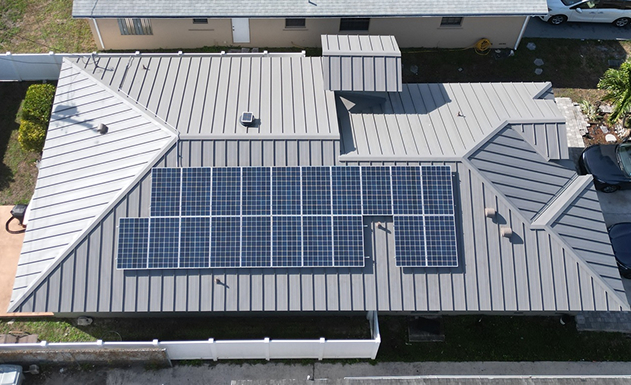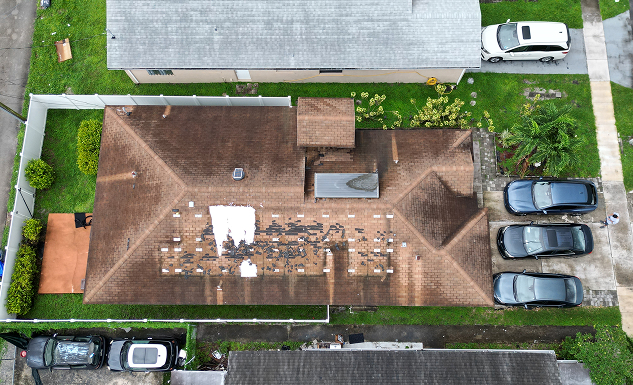© Planet Roofing 2025

trusted roofing contractor
Solar Installation
Planet Roofing Co is an expert roofing contractor with an office in Fort Lauderdale that serves all of Florida. As a licensed Roofing Company in Florida, we use hurricane-resistant materials for your new residential or commercial building.
or just TEXT or CALL
0% interest &
12 month no-pay
Get a new roof now
& delay the payments!
Thank you! We'll reply ASAP!
Solar Installation
Bringing Solar Power Home
So, you’re thinking about going solar? You’re not alone! In sunny South Florida, more and more homeowners are turning to solar power to save money and help the environment. But where do you start? Don’t worry – we’ve got you covered. Let’s dive into the basics of solar panels South Florida and why they’re a great option for homeowners like you.
How much does a new roof cost?
What roofing material is best for Florida?
Who are the most trusted roofing contractors in Florida?
Solar Installation
Why Go Solar In South Florida?
First things first, why should you consider solar panels for your home? Well, it’s simple – South Florida is practically a solar paradise! With all that sunshine, it just makes sense to harness the power of the sun to generate electricity for your home. Plus, by going solar, you can save money on your energy bills and reduce your carbon footprint. It’s a win-win!
-
Understanding the Costs of Solar Panels South Florida
Now, you might be wondering about the cost of going solar. It’s true that solar panels used to be expensive, but not anymore! Thanks to advancements in technology and government incentives, solar power is more affordable than ever. Plus, with financing options like the federal solar tax credit and PACE financing, you can make the switch to solar without breaking the bank. -
How Solar Panels Work
Okay, but how do solar panels actually work? It’s pretty cool, actually. Solar panels are made up of photovoltaic cells that convert sunlight into electricity. When sunlight hits the panels, it knocks electrons loose from the atoms in the cells, creating an electric current. This current is then converted into usable electricity that powers your home. It’s like magic – but science! -
Maximizing Your Savings
So, you’ve installed solar panels on your roof – now what? Sit back, relax, and watch the savings roll in! By generating your own electricity from the sun, you can say goodbye to expensive energy bills. Plus, with net metering, any excess energy your solar panels produce can be sold back to the grid, further reducing your costs. It’s like getting paid to go solar! -
Choosing the Right Solar Contractor
When it comes to installing solar panels, it’s important to choose the right contractor. You want someone who knows what they’re doing and can guide you through the process from start to finish. That’s where companies like Local Solar Corp come in. With their expertise and commitment to customer satisfaction, you can trust that your solar installation will be in good hands. -
Let’s Go Solar!
In conclusion, going solar in South Florida is a smart choice for homeowners looking to save money and reduce their environmental impact. With plenty of sunshine and a supportive regulatory environment, there’s never been a better time to make the switch. So why wait? Contact a trusted provider like Local Solar Corp today and talk a about how good it is to have Solar panels South Florida. Let’s bring solar power home – together!
Solar Installation
Essential Steps For Solar Panel Installation
With the rising awareness of sustainable energy solutions, more homeowners are considering solar panels to reduce energy bills and carbon footprints. Solar energy is not only beneficial for the environment but also offers potential savings on electricity costs. Installing solar panels is a significant investment, and understanding the process is crucial. This guide outlines the essential steps for solar panel installation, ensuring you make informed decisions and achieve the best results for your home.

Understanding the Basics of Solar Panel Installation
Before diving into the installation process, it’s important to understand what solar panel installation entails. Solar panels convert sunlight into electricity, which can power your home and reduce dependency on the grid. By harnessing renewable energy, homeowners can enjoy a more sustainable and cost-effective energy solution. Here’s a breakdown of what you should know.
Why Choose Local Solar Corp?
Simplicity
We make everything easy-peasy for you.
Roof Expertise
Ensuring both the roof and panels remain damage-free.
Energy Efficiency
As direct contractors for the Energy Efficiency Program, they can save you up to $5,000 in extra charges.
Solar Installation
Components of a Solar Electric System
A solar electric system consists of several key components:
Solar Panels
These capture sunlight and convert it into electricity. Different types of panels, such as monocrystalline, polycrystalline, and thin-film, offer varying efficiencies and price points.
Inverter
This device converts the direct current (DC) generated by the panels into alternating current (AC) used by most home appliances. It’s essential to choose an inverter that matches your system’s size and energy needs.
Mounting System
This is used to secure the panels to your roof. Roof-mounted systems are common, but ground-mounted systems are an option if roof space is limited.
Batteries (optional)
These store excess energy for use when sunlight is not available, providing energy security and independence from the grid.
Monitoring System
This tracks the performance of your solar power system, allowing you to ensure that it operates efficiently and detect any issues promptly.
Solar Installation
Assessing Your Energy Needs
The first step in installing solar panels is determining your energy requirements. Analyze your utility bills to understand your average monthly consumption. This information is vital when deciding the size of the solar system you need. Having a clear picture of your energy usage will guide you in selecting an appropriate system that meets your household’s demands.
Solar Installation
Calculating System Size
The size of your solar system depends on:
01. Your average energy usage
Review past electricity bills to calculate your average monthly and annual consumption. This will help determine the number of panels you need.
02. The available roof space
The amount of usable roof area dictates how many panels can be installed. Consider any obstacles that may limit installation space, such as chimneys or vents.
03. The efficiency of the solar panels you choose
Higher efficiency panels generate more electricity per square foot, which can be beneficial if roof space is limited.
Customer: Shoffet - Solar-Bid-Batteries
| Appliance | Power (W) | Percentage | AVR Hour Use | Units | Daily (W) |
|---|---|---|---|---|---|
| Fan Ceiling | 25 | 50 | 8 | 2 | 200 |
| HVAC 5 Ton | 5000 | 30 | 24 | 3 | 108000 |
| Light Bulb | 10 | 100 | 8 | 10 | 800 |
| Water Heater | 4000 | 100 | 1.5 | 1 | 6000 |
| Refrigerator | 750 | 20 | 24 | 3 | 10800 |
| Electric Top | 5000 | 30 | 1 | 1 | 1500 |
| Microwave | 1000 | 75 | 0.2 | 1 | 150 |
| Dishwasher | 1500 | 60 | 1 | 1 | 900 |
| Coffee Maker | 1000 | 30 | 2 | 1 | 600 |
| TV-S | 100 | 80 | 8 | 3 | 1920 |
| Desktop PC | 150 | 30 | 8 | 2 | 720 |
| Pool Pump | 150 | 30 | 12 | 1 | 540 |
| Others | 5000 | 50 | 2 | 1 | 5000 |
| Total Watts | 137130 | ||||

Solar Installation
Evaluating Your Roof Condition
Not every roof is suitable for solar panel installation. Your roof should be in good condition and have a suitable pitch and orientation to maximize sun exposure. The ideal roof will face south in the northern hemisphere, ensuring maximum sunlight capture throughout the day.
Roof Inspection
Before installation, have a professional inspect your roof for:
01. Structural integrity
Ensure your roof can support the additional weight of the solar panels. Weak or damaged areas may require reinforcement or repair.
02. Shading from trees or other buildings
Identify any potential sources of shade that could impact solar panel performance. Trimming trees or choosing a different installation site may be necessary.
03. Roof angle and orientation
The angle and direction of your roof affect solar efficiency. A roof with a pitch between 15 and 40 degrees is typically ideal.
If your roof needs repairs, address these before proceeding with the solar panel installation. A well-prepared roof ensures the longevity and efficiency of your solar system.
If your roof needs repairs, address these before proceeding with the solar panel installation. A well-prepared roof ensures the longevity and efficiency of your solar system.
Solar Installation
Understanding Costs And Financing Options
The cost of solar panel installation can vary significantly based on several factors, including location, system size, and the solar installation company you choose. Understanding these costs can help you budget effectively and explore ways to reduce expenses.
Solar Installation
Breaking Down the Costs
01. Equipment Costs
This includes the cost of solar panels, inverters, and other components. Prices can vary based on the technology and brand you choose.
02. Installation Costs
Labor and permits can add to the overall cost. Installation complexity and local regulations can influence pricing.
03. Additional Expenses
These might include maintenance and battery storage if you opt for it. Consider the long-term savings these components can offer.
Solar Installation
Financing Financing
Explore various financing options to make solar installation affordable:
01. Cash Purchase
Paying upfront maximizes long-term savings, allowing you to avoid interest payments and benefit from immediate energy savings.
02. Solar Loans
These allow you to pay over time, making solar more accessible to those who cannot afford the upfront cost.
03. Leases and Power Purchase Agreements (PPAs)
You can lease the system or pay for the power generated, offering lower initial costs and flexible payment plans.
Research incentives and tax credits available in your area, which can significantly reduce the cost of solar panel installation. Many governments offer financial incentives to encourage renewable energy adoption, providing opportunities for additional savings.
Solar Installation
Selecting A Solar Installation Contractor
Choosing the right solar installation contractor is crucial for a successful installation. A reputable contractor will ensure quality workmanship and guide you through the installation process with expertise and transparency. Here are some tips to guide you:
Solar Installation
What to Look For
Meeting with multiple contractors can help you compare quotes and services, ensuring you get the best value. Thoroughly vetting potential contractors reduces the risk of complications during and after installation.
01. Experience
This includes the cost of solar panels, inverters, and other components. Prices can vary based on the technology and brand you choose.
02. Reputation
Check reviews and ask for references. Customer feedback and testimonials can provide insight into a contractor’s reliability and service quality.
03. Certifications
Look for certifications such as NABCEP (North American Board of Certified Energy Practitioners). Certified professionals are held to high industry standards.
04. Warranties
Understand the warranties offered on both the equipment and installation. Comprehensive warranties provide peace of mind and protection for your investment.
Solar Installation
Installation Process
Once you’ve selected a contractor, the installation process begins, typically taking one to three days, depending on the system’s size and complexity. The contractor will outline a timeline and keep you informed of each phase of the project.
Solar Installation
Installation Steps
01. Permits and Paperwork
Your contractor will handle the necessary permits and paperwork. This step ensures compliance with local regulations and safety standards.
02. Mounting the Panels
The mounting system is installed first, followed by the solar panels. Proper installation is critical to ensure durability and optimal performance.
03. Electrical Wiring
This connects the panels to your inverter and electrical panel. Qualified electricians ensure safe and efficient wiring.
04. System Inspection
A thorough inspection ensures everything is installed correctly and safely. Inspectors verify that the system meets all regulatory requirements.
05. Connecting to the Grid
Finally, the system is connected to the grid, and you can start generating solar power. The utility company may need to approve the connection before the system goes live.
Solar Installation
Post-Installation Maintenance
Solar panels require minimal maintenance. However, regular checks can ensure optimal performance and extend the lifespan of your system. Proactive maintenance helps identify and resolve issues before they impact energy generation.
Solar Installation
Maintenance Tips
01. Clean Panels
Dust and debris can reduce efficiency, so clean your panels periodically. Use water and a soft brush to prevent damage to the panels’ surface.
02. Monitor Performance
The mounting system is installed first, followed by the solar panels. Proper installation is critical to ensure durability and optimal performance.
03. Schedule Inspections
Have a professional inspect the system annually to ensure everything is functioning correctly. Regular inspections can catch minor issues before they become significant problems.
Ready To Harnesse The Power Of The Sun
Contact Planet Roofing today and illuminate your path to a sustainable future!
Planet Roofing
Our Promise
We are roofing professionals that treat every home like their own. We are professionals at staying on budget, and completing projects on time.

John
President
- 100 N. Federal Highway, Fort Lauderdale, Fl 33301
Drop us a line

Thank you! We'll reply ASAP!


